Age and Growth Characteristics of Okamejei kenojei in the West Sea of South Korea According to Coronal Vertebral Microstructure
Abstract
1. Introduction
2. Materials and Methods
2.1. Fish Sample Collection
2.2. Analysis Method
2.2.1. Measurement of Vertebrae Variability
2.2.2. Vertebrae Preprocessing
2.2.3. Age Assessment and Verification
2.3. Identification of Growth Bands
2.4. Spawning Season
2.5. Growth Formula
2.6. Statistical Analyses
3. Results
3.1. Size and Weight of Specimens
3.2. Growth Bands
3.3. Monthly Change in Marginal Index
3.4. Monthly Change in Gonadosomatic Index (GSI) and Female Egg Capsule Appearance
3.5. Back Calculation of Disc Width and Body Weight When Forming a Growth Band
3.6. Growth Equation Estimation
4. Discussion
5. Conclusions
Author Contributions
Funding
Institutional Review Board Statement
Data Availability Statement
Acknowledgments
Conflicts of Interest
References
- Chilton, D.E.; Beamish, R.J. Age determination methods for fishes studied by the Groundfish Program at the Pacific Biological Station. Can. Spec. Publ. Fish. Aquat. Sci. 1982, 60, 102. [Google Scholar]
- Campana, S.E. Age Determination of Elasmobranchs, with Special Reference to Mediterranean Species: A Technical Manual; Studies and Reviews; General Fisheries Commission for the Mediterranean: Rome, Italy, 2013; Volume 94, pp. 1–44. [Google Scholar]
- Campana, S.E. Accuracy, precision and quality control in age determination, including a review of the use and abuse of age validation methods. J. Fish Biol. 2001, 59, 197–242. [Google Scholar] [CrossRef]
- Nazir, A.; Khan, M.A. Stock-specific assessment of precise age and growth in the long-whiskered catfish Sperata aor from the Ganges River. Mar. Freshw. Res. 2020, 71, 1693–1701. [Google Scholar] [CrossRef]
- Khan, M.A.; Nazir, A.; Banday, U.Z. Utility of otolith weight to estimate age of Labeo bata (Actinopterygii: Cypriniformes: Cyprinidae) inhabiting the Ganga River. Acta Ichthyol. Piscat. 2018, 48, 257–260. [Google Scholar] [CrossRef]
- Cha, B.Y.; Park, Y.C.; Huh, S.H. Age and growth of the Yellow goosefish, Lophius litulon. J. Korea Fish. Soc. 1998, 31, 529–534. [Google Scholar]
- Smith, S.E.; Mitchell, R.A.; Fuller, D. Age-validation of a leopard shark (Triakis semifasciata) recaptured after 20 years. J. Fish. Bull. NOAA 2003, 101, 194–198. [Google Scholar]
- Kume, G.; Furumitsu, K.; Yamaguchi, A. Age, growth and age at sexual maturity of fan ray Platyrhina sinensis (Batoidea: Platyrhinidae) in Ariake Bay, Japan. Fish. Sci. 2008, 74, 736–742. [Google Scholar] [CrossRef]
- James, A.S.; Michael, D.M.; Seung, H.S.; William, H.H. Age and growth estimates of the winter skate (Leucoraja ocellata) in the western Gulf of Maine. J. Fish. Bull. 2003, 3, 161–168. [Google Scholar]
- Matta, M.E.; Kimura, D.K. Age Determination Manual of the Alaska Fisheries Science Center Age and Growth Program; NOAA: Anchorage, AK, USA, 2012; Volume 13, pp. 1–97. [Google Scholar]
- Beamish, R.J.; McFarlane, G.A. The forgotten requirement for age validation in fisheries biology. Trans. Am. Fish. Soc. 1983, 112, 735–743. [Google Scholar] [CrossRef]
- Kim, J.K.; Sim, D.S.; Jeong, S.D. Sexual maturity of Raja koreana (Elasmobranchii, Rajoidei) from Korea. Korean J. Ichthyol. 2005, 17, 229–235. [Google Scholar]
- Mcfarlane, G.A.; King, J.R. Age and growth of big skate (Raja binoculata) and longnose skate (Raja rhina) in British Columbia waters. J. Fish. Res. 2006, 78, 169–178. [Google Scholar] [CrossRef]
- Serra-Pereira, B.; Figueiredo, I.; Farias, I.; Moura, T.; Gordo, L.S. Description of dermal denticles from the caudal region of Raja clavata and their use for the estimation of age and growth. J. Mar. Sci. 2008, 65, 1701–1709. [Google Scholar] [CrossRef]
- Jang, M.H. Age and Growth of Mottled Skate (Bering Rajapulchra) in the Yellow Sea of Korea; Korean Inha University: Incheon, South Korea, 2014; pp. 1–49. [Google Scholar]
- Joung, S.J.; Chen, C.C.; Liu, K.M.; Hsieh, T.C. Age and Growth Estimates of the Kwangtung Skate Dipturus kwangtungensis in the Waters of Northern Taiwan; Cambridge University Press: Cambridge, UK, 2015; p. 28. [Google Scholar]
- Youn, B.I.; Choi, D.H.; Lee, S.H.; Han, K.H.; Lee, S.J.; Kwon, D.H.; Kim, M.J. Spawning Period and Size at Maturity of the Ocellate Spot skate Okamejei kenojei in the West Sea of Korea. J. Mar. Sci. Eng. 2022, 10, 1067. [Google Scholar] [CrossRef]
- Von Bertalanffy, L.A. quantitative theory of organic growth (Inquiries on growth laws. II). Hum. Biol. 1938, 10, 181–213. [Google Scholar]
- Hoff, G.R. A nursery site of the Alaska skate (Bathyraja parmifera) in the eastern Bering Sea. Fish. Bull. 2008, 106, 233–244. [Google Scholar]
- Hong, S.H.; Yeon, I.J.; Im, Y.J.; Hwang, H.J.; Ko, T.S.; Park, Y.C. Feeding Habits of the Ocellate Spot Skate (Okamejei kenojei) in the Yellow Sea of Korea; NIFS (National Institute of Fisheries Science) Press: Indianapolis, IN, USA, 2000; Volume 58, pp. 1–9. [Google Scholar]
- Zhang, C.I. Marine Fisheries Resource Ecology; Pukyong University Press: Busan, Korea, 2010; pp. 195–216. [Google Scholar]
- Jeon, J.C.; Lim, Y.J. Age and growth of Stone2 flounder, Kareius bicoloratus, in western coastal waters of Korea. Korean J. Ichthyol. 2004, 16, 173–180. [Google Scholar]
- Zhang, C.I. Age and growth of the flathead grey mullet (Mugil cephalus) in the coastal water of Yeosu. J. Fish. Ocean. Technol. Korean Soc. 2005, 47, 203–213. [Google Scholar] [CrossRef]
- Hara, K.; Furumitsu, K.; Aoshima, T.; Kanehara, H.; Yamaguchi, A. Age, growth, and age at sexual maturity of the commercially landed skate species, Dipturus chinensis (Basilewsky, 1855), in the northern East China Sea. J. Appl. Ichthyol. 2018, 34, 66–72. [Google Scholar] [CrossRef]
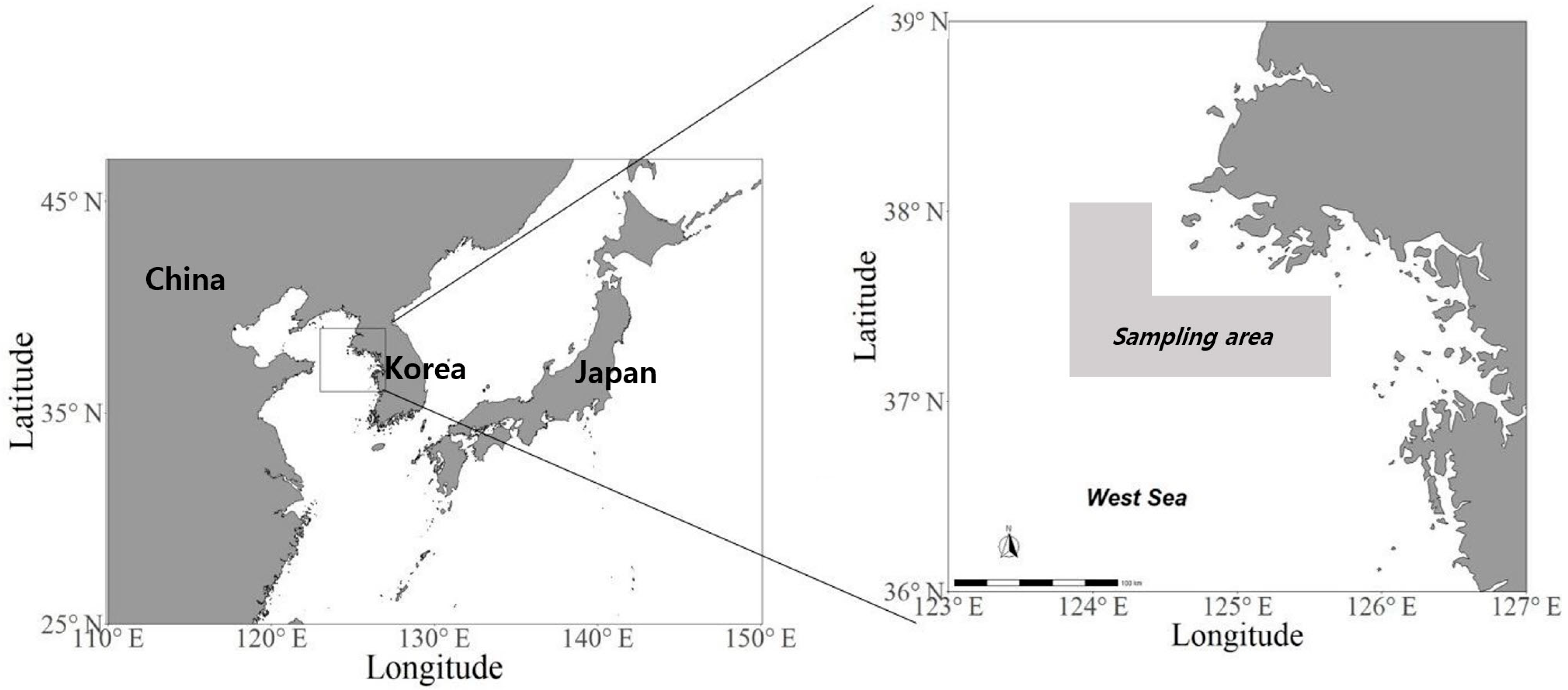

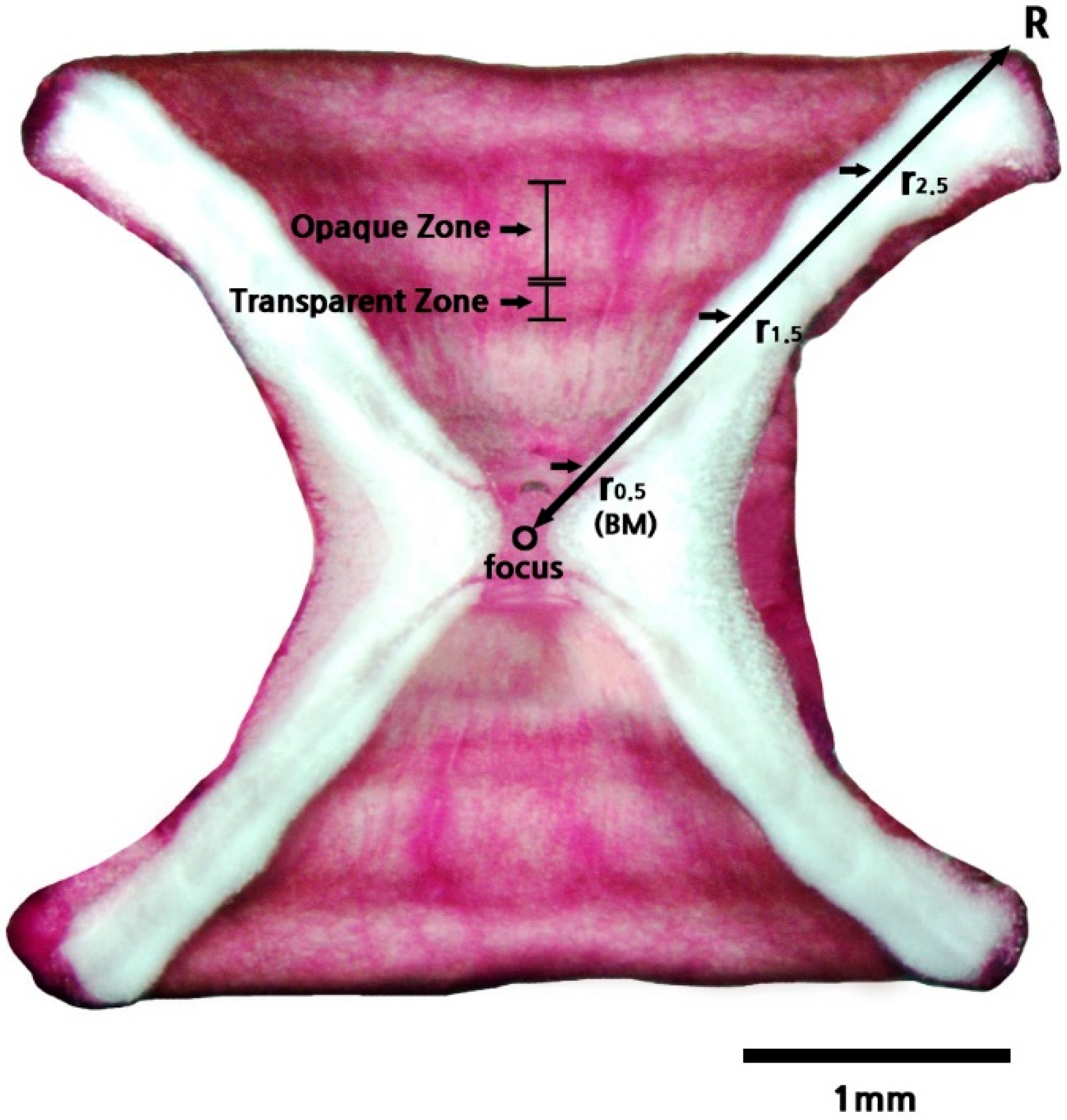
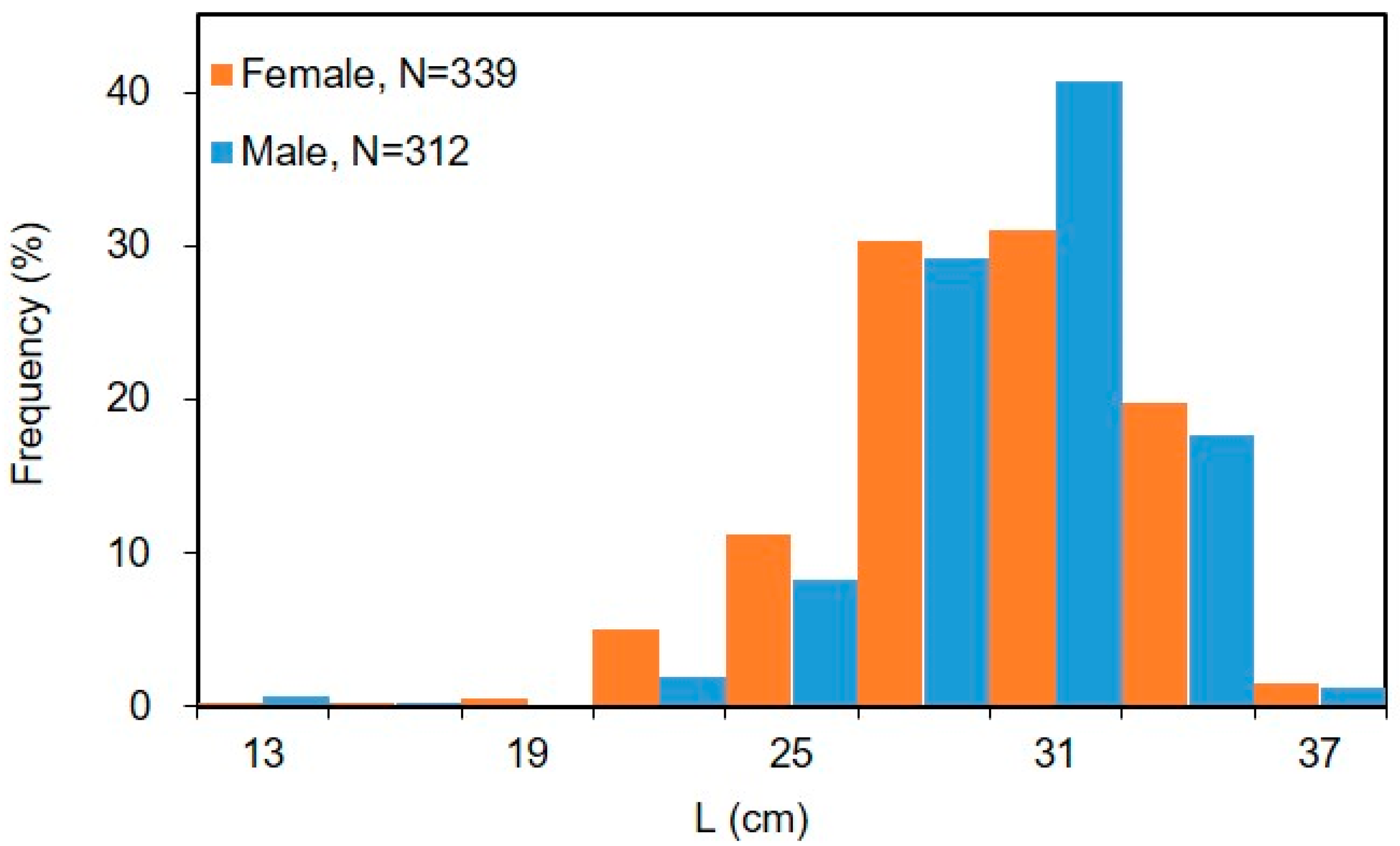
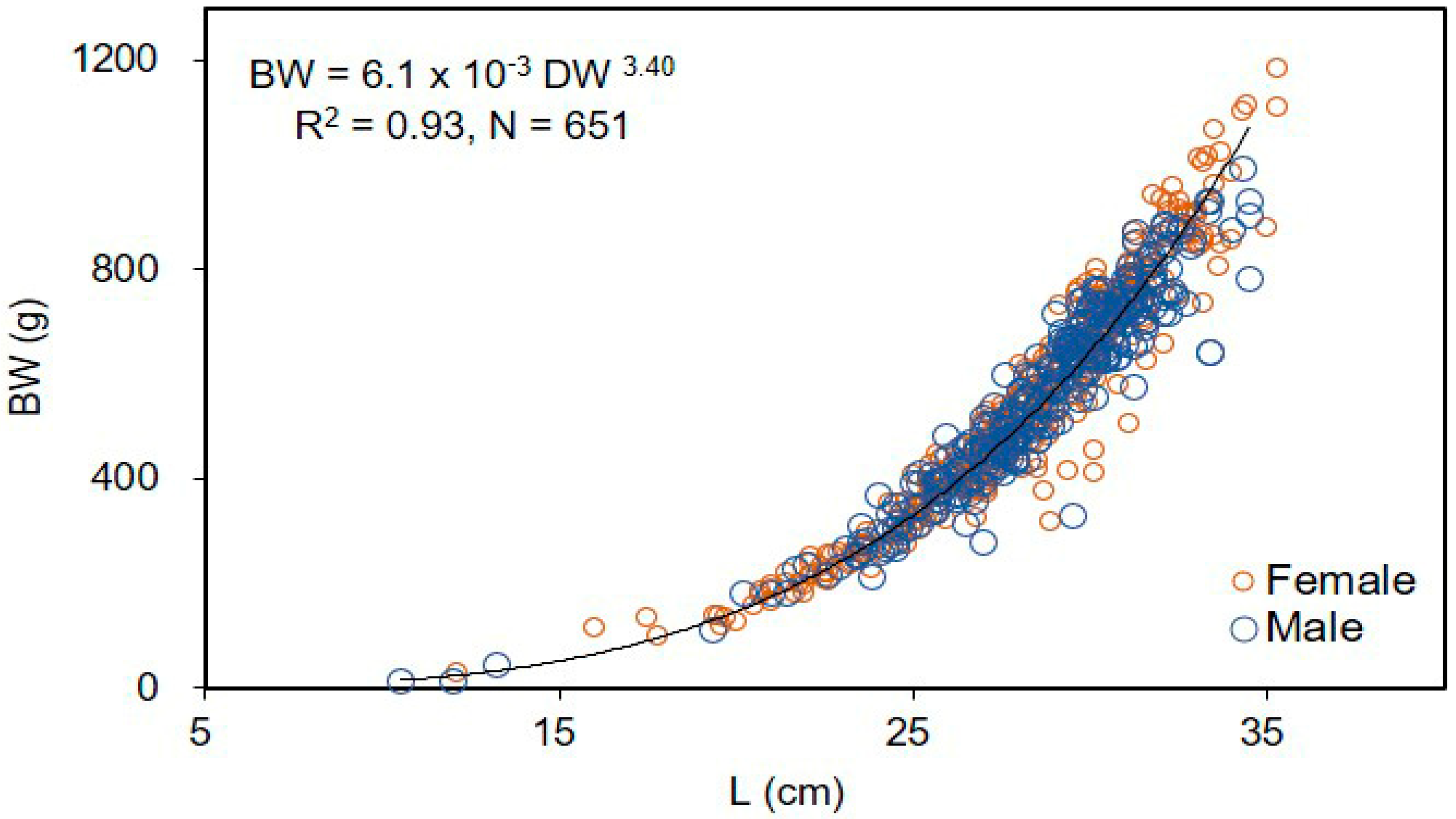

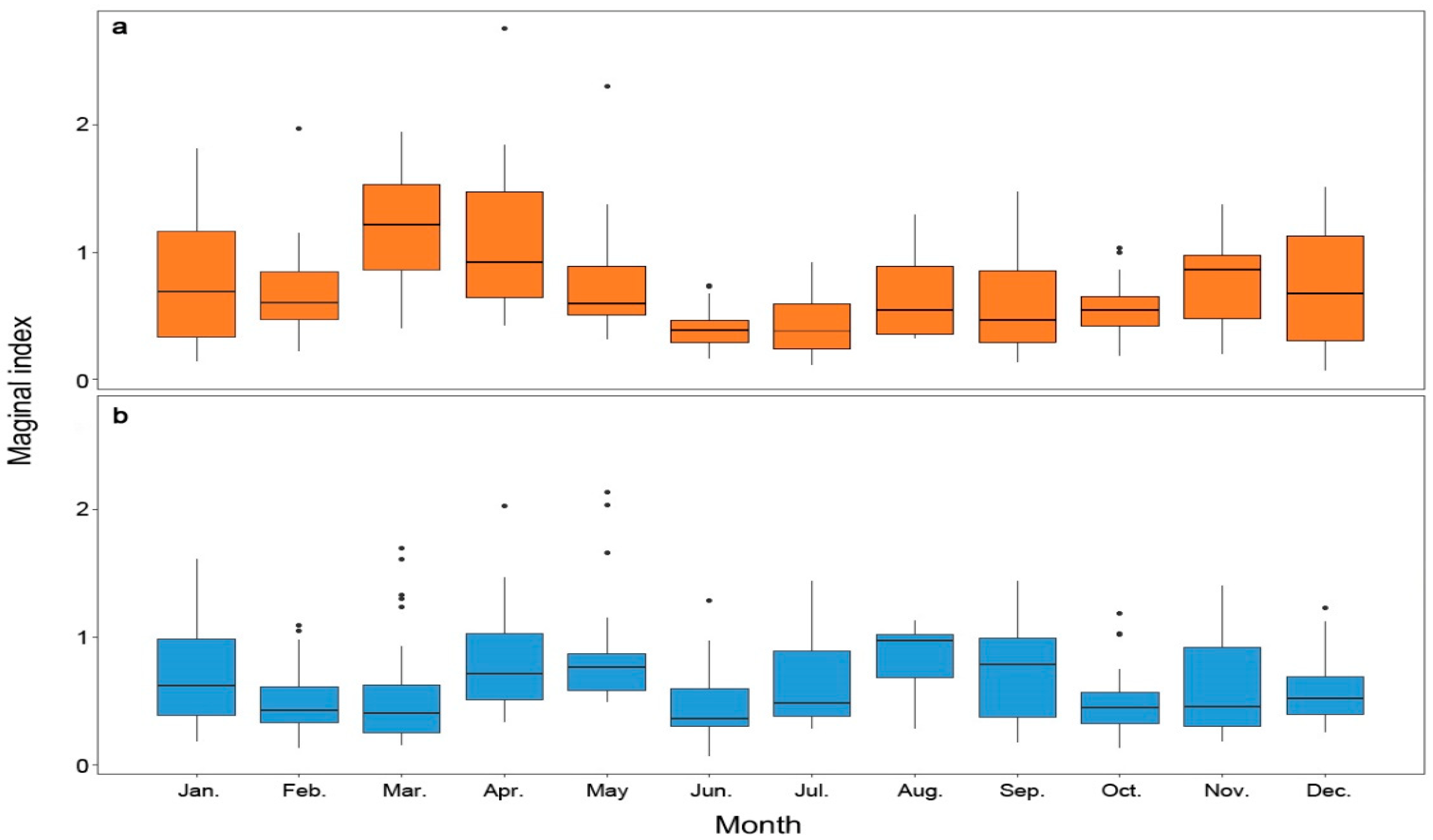
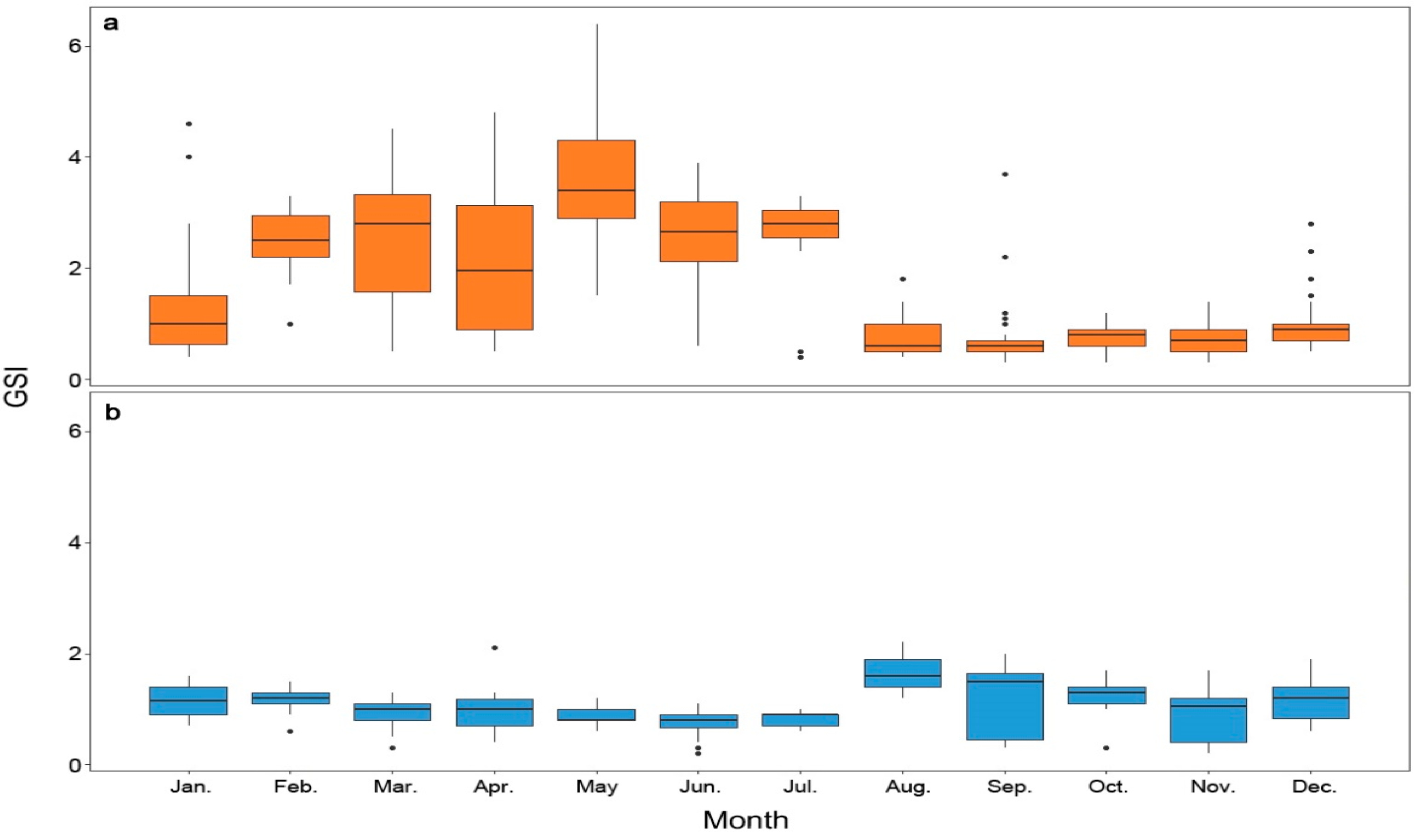
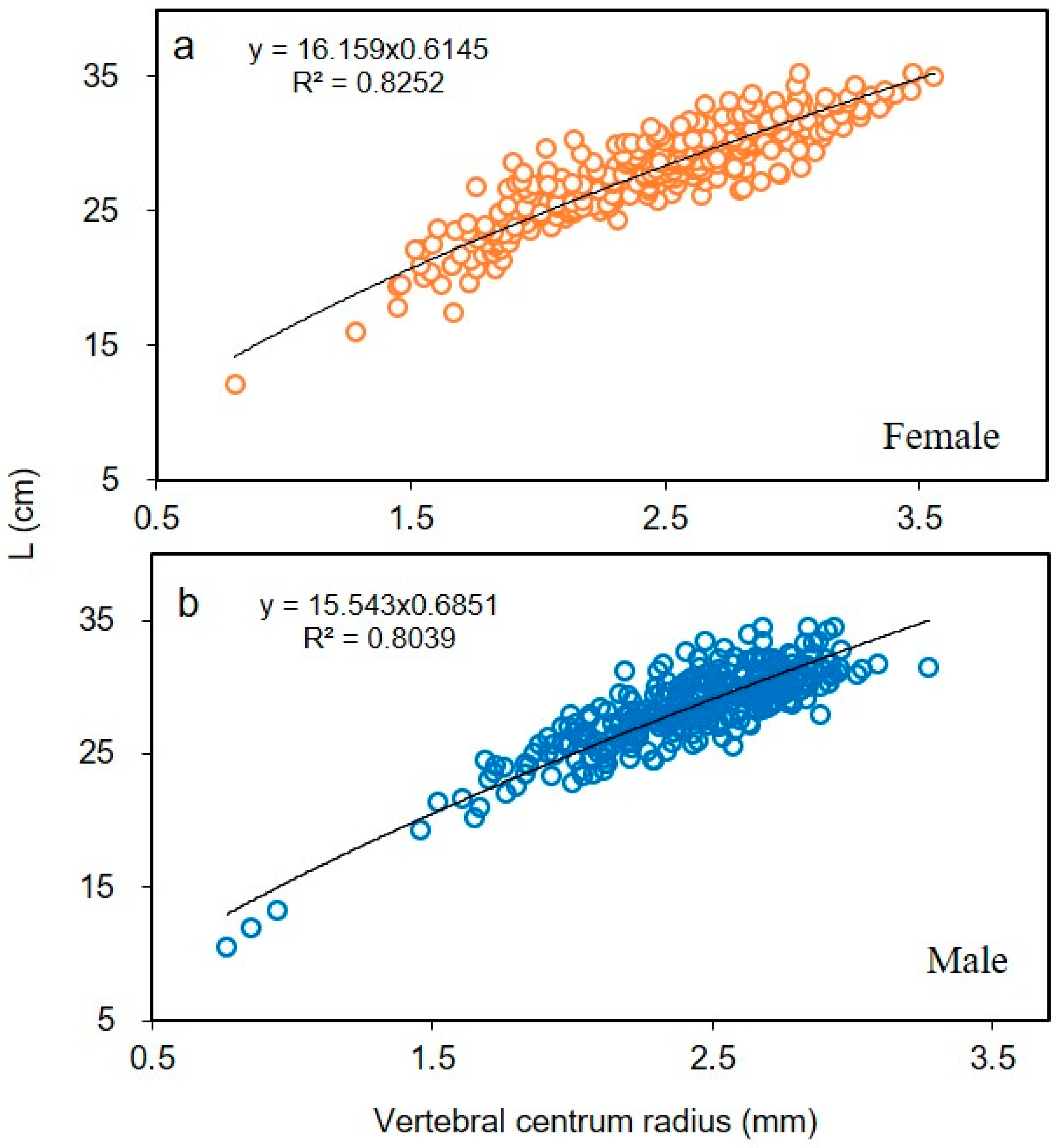
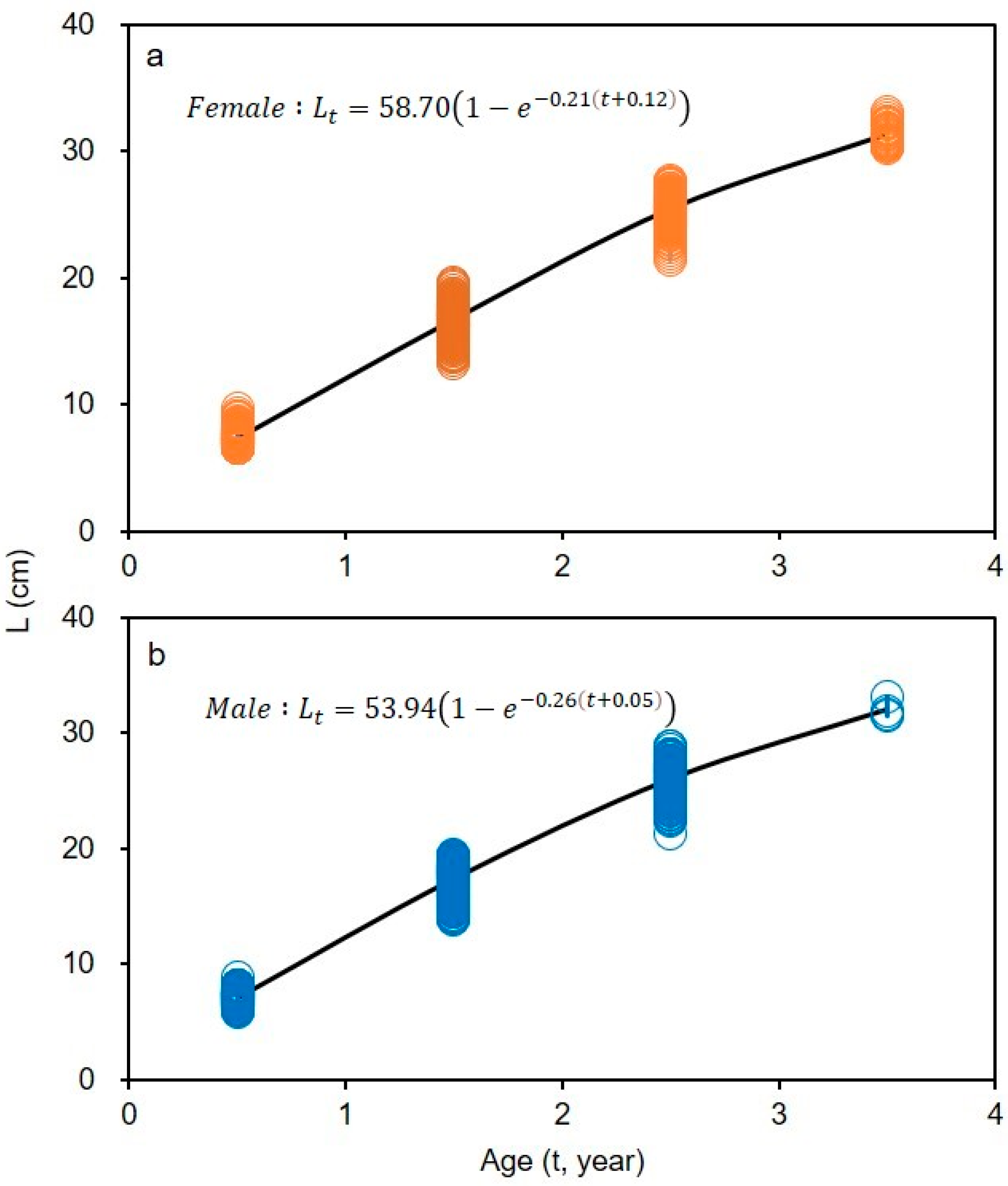
| Year | Month | No. of Fish (N) | Disc Width Range (Mean (cm) ± SD) | ||
|---|---|---|---|---|---|
| Female | Male | Female | Male | ||
| 2019 | Jan. | 30 | 30 | 22.1–33.5 (27.5 ± 2.9) | 23.5–32.1 (28.0 ± 2.4) |
| Feb. | 30 | 30 | 28.9–35.3 (31.7 ± 1.8) | 27.3–34.5 (30.6 ± 1.7) | |
| Mar. | 30 | 30 | 17.8–31.8 (23.9 ± 3.3) | 24.4–34.3 (29.7 ± 2.2) | |
| Apr. | 30 | 29 | 22.7–33.7 (28.7 ± 3.1) | 21.7–32.4 (28.5 ± 2.9) | |
| May | 32 | 33 | 12.1–33.2 (28.6 ± 5.8) | 10.5–33.3 (28.9 ± 6.3) | |
| Jun. | 30 | 23 | 21.0–32.0 (27.3 ± 2.2) | 19.3–32.9 (27.5 ± 3.4) | |
| Jul. | 30 | 29 | 26.7–33.5 (30.6 ± 1.8) | 25.5–31.3 (28.8 ± 1.5) | |
| Aug. | 7 | 13 | 24.5–31.6 (27.8 ± 2.3) | 22.3–31.0 (27.2 ± 2.2) | |
| Sep. | 30 | 15 | 21.0–33.6 (26.6 ± 2.8) | 20.2–29.1 (25.4 ± 2.6) | |
| Oct. | 30 | 20 | 22.9–33.1 (28.6 ± 2.2) | 23.1–31.3 (27.8 ± 2.1) | |
| Nov. | 30 | 30 | 20.7–35.0 (26.9 ± 4.5) | 21.0–30.5 (26.2 ± 2.2) | |
| Dec. | 30 | 30 | 23.6–32.5 (27.9 ± 2.1) | 26.1–33.4 (28.8 ± 1.9) | |
| Total | 339 | 312 | 12.1–35.3(28.0 ± 3.7) | 10.5–34.5(28.3 ± 3.3) | |
| Year | Month | Number of Individuals (A) | Number of Individuals Possessing Egg Capsules (B) | Egg Capsule Appearance Rate (B/A, %) |
|---|---|---|---|---|
| 2019 | Jan. | 30 | - | 0.0 |
| Feb. | 30 | - | 0.0 | |
| Mar. | 32 | 1 | 3.1 | |
| Apr. | 30 | 3 | 10.0 | |
| May | 43 | 9 | 20.9 | |
| Jun. | 30 | 15 | 50.0 | |
| Jul. | 30 | 21 | 70.0 | |
| Aug. | 7 | - | 0.0 | |
| Sep. | 30 | 1 | 3.3 | |
| Oct. | 29 | - | 0.0 | |
| Nov. | 30 | - | 0.0 | |
| Dec. | 30 | - | 0.0 |
| Female | ||||||||
|---|---|---|---|---|---|---|---|---|
| t (year) | Back-Cal. Disc Width (cm) | VBGE Disc Width (cm) | Residual | SS | L∞ (cm) | K | t0 | SSQ |
| 0.5 | 7.32 | 7.22 | 0.099 | 0.010 | 38.8 | 0.21 | −0.12 | 0.307 |
| 1.5 | 16.72 | 17.06 | −0.343 | 0.118 | ||||
| 2.5 | 25.41 | 25.02 | 0.395 | 0.156 | ||||
| 3.5 | 31.30 | 31.45 | −0.151 | 0.023 | ||||
| Male | ||||||||
| 0.5 | 7.10 | 7.04 | 0.056 | 0.003 | 39.08 | 0.26 | −0.05 | 0.108 |
| 1.5 | 17.41 | 17.61 | −0.200 | 0.040 | ||||
| 2.5 | 26.04 | 25.80 | 0.238 | 0.056 | ||||
| 3.5 | 32.05 | 32.14 | −0.093 | 0.009 | ||||
| Species | Locality of Study | L∞ (cm) | K | t0 | Max. Age (years) | Material | Reference | ||
|---|---|---|---|---|---|---|---|---|---|
| Okamejei kenojei | West Sea, South Korea | F | 38.8 | (L) | 0.21 | −0.12 | 3.5 | Veterbral | This study |
| M | 39.1 | (L) | 0.29 | −0.05 | |||||
| Beringraja pulchra | West Sea, South Korea | F | 101.7 | (L) | 0.35 | 0.09 | 4.25 | Veterbral | [15] |
| M | 72.5 | (L) | 0.55 | 0.08 | |||||
| Dipturus chinensis | Northern East China sea | F | 83.1 | (TL) | 0.103 | −1.20 | 15 | Veterbral | [24] |
| M | 76.8 | (TL) | 0.109 | −1.28 | 13 | ||||
| Raja clavata | Northern Atlantic Current | F | 140.7 | (TL) | 0.097 | −0.88 | 10 | Caudal thorn | [14] |
| M | 117.1 | (TL) | 0.142 | −0.36 |
Disclaimer/Publisher’s Note: The statements, opinions and data contained in all publications are solely those of the individual author(s) and contributor(s) and not of MDPI and/or the editor(s). MDPI and/or the editor(s) disclaim responsibility for any injury to people or property resulting from any ideas, methods, instructions or products referred to in the content. |
© 2023 by the authors. Licensee MDPI, Basel, Switzerland. This article is an open access article distributed under the terms and conditions of the Creative Commons Attribution (CC BY) license (https://creativecommons.org/licenses/by/4.0/).
Share and Cite
Youn, B.-I.; Choi, D.-H.; Roh, T.-H.; Lee, S.-H.; Han, K.-H.; Kwon, D.-H.; Kim, M.-J. Age and Growth Characteristics of Okamejei kenojei in the West Sea of South Korea According to Coronal Vertebral Microstructure. Fishes 2023, 8, 197. https://doi.org/10.3390/fishes8040197
Youn B-I, Choi D-H, Roh T-H, Lee S-H, Han K-H, Kwon D-H, Kim M-J. Age and Growth Characteristics of Okamejei kenojei in the West Sea of South Korea According to Coronal Vertebral Microstructure. Fishes. 2023; 8(4):197. https://doi.org/10.3390/fishes8040197
Chicago/Turabian StyleYoun, Byoung-Il, Dong-Hyuk Choi, Tae-Hyoung Roh, Seung-Hwan Lee, Kyeong-Ho Han, Dae-Hyeon Kwon, and Maeng-Jin Kim. 2023. "Age and Growth Characteristics of Okamejei kenojei in the West Sea of South Korea According to Coronal Vertebral Microstructure" Fishes 8, no. 4: 197. https://doi.org/10.3390/fishes8040197
APA StyleYoun, B.-I., Choi, D.-H., Roh, T.-H., Lee, S.-H., Han, K.-H., Kwon, D.-H., & Kim, M.-J. (2023). Age and Growth Characteristics of Okamejei kenojei in the West Sea of South Korea According to Coronal Vertebral Microstructure. Fishes, 8(4), 197. https://doi.org/10.3390/fishes8040197






